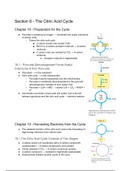Samenvatting
Samenvatting "Biochemistry: A Short Course" (John L. Tymoczko) Section 8 (H18 en H19)
Samenvatting "Biochemistry: A Short Course" (John L. Tymoczko) Section 8 (H18 en H19). Deze samenvatting is gemaakt voor het vak "Cel tot Molecuul" van de studie diergeneeskunde.
[Meer zien]





